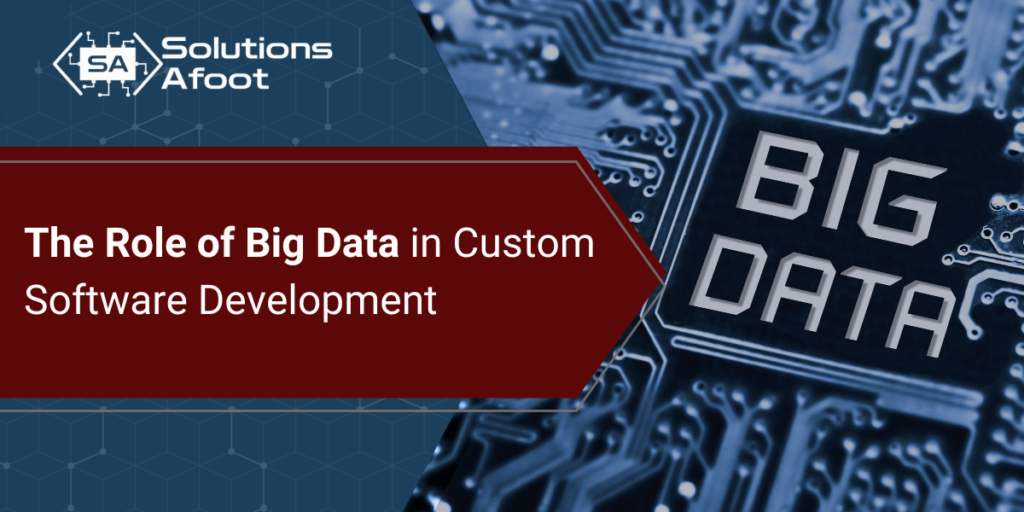The Role of Big Data in Custom Software Development

Integrating Big Data Analytics into Custom Software Solutions: Extracting Valuable Insights and Driving Informed Decision-Making
In the era of digital transformation, the ability to harness and analyze vast amounts of data has become crucial for businesses aiming to stay competitive. Big data analytics provides organizations with the tools and techniques to extract valuable insights, enabling informed decision-making and strategic planning. By integrating big data analytics into custom software solutions, businesses can unlock new opportunities, streamline operations, and enhance customer experiences.
The Power of Big Data Analytics
Big data refers to the large volumes of structured and unstructured data generated by various sources such as social media, sensors, transactions, and more. Big data analytics involves examining these massive datasets to uncover patterns, correlations, trends, and other actionable insights. The key benefits of big data analytics include:
1. Enhanced Decision-Making: Data-driven decisions are more accurate and reliable, reducing risks and improving outcomes.
2. Improved Operational Efficiency: By analyzing data, businesses can identify inefficiencies, optimize processes, and reduce costs.
3. Personalized Customer Experiences: Understanding customer behavior and preferences allows businesses to tailor products and services to meet individual needs.
4. Innovative Opportunities: Analyzing data can reveal new market trends and opportunities, fostering innovation and growth.
Integrating Big Data Analytics into Custom Software Solutions
Custom software solutions offer the flexibility and scalability needed to integrate big data analytics effectively. Here’s how businesses can incorporate big data analytics into their custom applications:
1. Data Collection and Storage
The first step in big data analytics is collecting and storing data. Custom software solutions can be designed to capture data from various sources, including:
– Transactional Data: Sales, purchases, and other business transactions.
– User Data: Behavior and interactions on websites and applications.
– Sensor Data: Information from IoT devices and sensors.
– Social Media Data: Posts, comments, and interactions on social platforms.
Data can be stored in scalable databases such as Hadoop, Apache Cassandra, or cloud-based solutions like Amazon S3 and Google Cloud Storage, ensuring efficient handling of large volumes of data.
2. Data Processing
Processing big data involves cleaning, transforming, and organizing data for analysis. Custom software solutions can utilize tools and frameworks to streamline this process:
– Apache Spark: An open-source analytics engine for large-scale data processing, offering in-memory processing capabilities.
– Apache Flink: A framework for stream processing and batch processing, enabling real-time data analysis.
– ETL Tools: Extract, Transform, Load (ETL) tools like Talend and Apache Nifi automate the process of moving and transforming data from various sources into a usable format.
3. Data Analysis and Visualization
Once the data is processed, it’s time to analyze and visualize it. Custom software solutions can integrate advanced analytics tools and techniques to extract meaningful insights:
– Machine Learning: Algorithms and models, such as regression analysis, classification, and clustering, can predict trends and identify patterns.
– Data Mining: Techniques like association rule learning and anomaly detection uncover hidden relationships in data.
– Visualization Tools: Integrating tools like Tableau, Power BI, and D3.js allows businesses to create interactive and intuitive visualizations, making data insights accessible and actionable.
4. Real-Time Analytics
For businesses requiring immediate insights, real-time analytics is essential. Custom software solutions can leverage stream processing technologies to analyze data as it’s generated:
– Apache Kafka: A distributed streaming platform for building real-time data pipelines and streaming applications.
– Amazon Kinesis: A platform for real-time processing of streaming data at scale.
Real-time analytics enables businesses to make quick decisions, respond to events as they happen, and maintain a competitive edge.
Tools and Techniques for Processing and Analyzing Big Data
Several tools and techniques are crucial for processing and analyzing big data effectively. Here’s a closer look at some of the most popular ones:
Hadoop Ecosystem
– Hadoop HDFS: A distributed file system that stores large datasets across multiple machines.
– MapReduce: A programming model for processing large data sets with a parallel, distributed algorithm.
– Hive: A data warehouse infrastructure built on Hadoop, providing data summarization and query capabilities.
NoSQL Databases
– MongoDB: A document-oriented NoSQL database that stores data in flexible, JSON-like documents.
– Cassandra: A distributed NoSQL database designed to handle large amounts of data across many commodity servers.
Data Warehousing Solutions
– Amazon Redshift: A fully managed data warehouse service in the cloud.
– Google BigQuery: A serverless, highly scalable data warehouse designed for fast SQL queries.
Machine Learning Libraries
– TensorFlow: An open-source library for machine learning and artificial intelligence.
– Scikit-learn: A library for machine learning in Python, providing simple and efficient tools for data analysis.
Conclusion
Integrating big data analytics into custom software solutions empowers businesses to extract valuable insights and make informed decisions. By leveraging the right tools and techniques, organizations can process and analyze vast amounts of data, uncovering patterns and trends that drive strategic planning and operational efficiency. As the digital landscape continues to evolve, embracing big data analytics will be essential for businesses aiming to thrive in a data-driven world.
